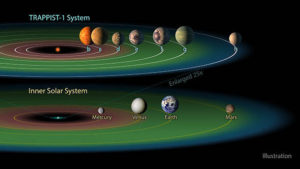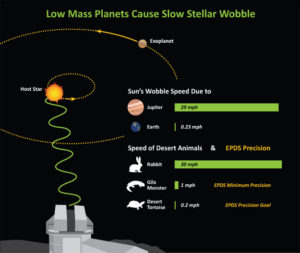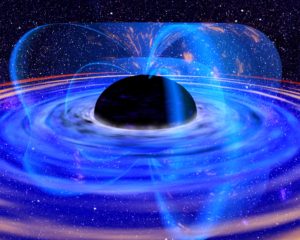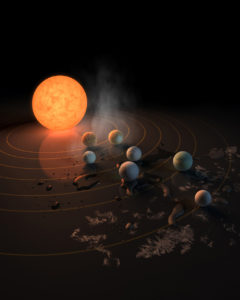 We have a theory – a lot of theories, actually – about how the Universe works. On scales big and small, from the entire cosmos to the threads that bind of the fabric of space to the continuum of time, we’ve come up with ideas about how this all holds together.
We have a theory – a lot of theories, actually – about how the Universe works. On scales big and small, from the entire cosmos to the threads that bind of the fabric of space to the continuum of time, we’ve come up with ideas about how this all holds together.
Most of these ideas are wrong.
In February 1998, I was freezing my fingers and toes off in the control room at the Lick Observatory looking for exoplanets. The observatory – a drafty hundred-year-old dome at the top of Mt. Hamilton just east of San Jose – was, in spite of the growing glare from Silicon Valley below, one of the better places at the time to go planet-hunting. Back then, our eyes on the sky weren’t so sharp. We didn’t have the really cool toys like the Hubble Space Telescope, the Spitzer Space Telescope 1, and the TRAPPIST observatory in South America. Back then, in order to find an exoplanet, we had to look for star-wobbles.
The force of an object is related to that object’s mass and motion. Planets have mass, so they exert forces on nearby objects,  including their own stars, as they zip around them. We don’t see the star itself shaking from one side to the other, like a big kid caught in a game of a tug-of-war between two smaller siblings2. What we see is the light from those stars becoming slightly longer-waved, and then slightly shorter-waved, like a slinky being ever-so-slightly pushed and pulled.
including their own stars, as they zip around them. We don’t see the star itself shaking from one side to the other, like a big kid caught in a game of a tug-of-war between two smaller siblings2. What we see is the light from those stars becoming slightly longer-waved, and then slightly shorter-waved, like a slinky being ever-so-slightly pushed and pulled.
We were up at Lick that night in search of a slinky slinking back forth at a speed of a fast human or a slow rabbit3. Fast, but not too fast. Like we said before, regularly shifting starlight is often a sign of mass moving regularly around a star. Smaller shifts are more likely to be smaller bodies, like planets. Big shifts are things like other stars – which we can sometimes see radiating at us from across the void – or black holes and other weird objects4. 
What did we find? That night, stars were wobbling. It would take years of watching them wobble to satisfy ourselves and our community that the wobbles were due to planets the size of a small Jupiter (which is about what you could see from the Lick at the time). When the view cleared up, what we found (among many things) is that:
- What the stars are made of corresponds with what the gas giants are made of! Lots of metal of a certain type in the star -> lots of metal of that type in the gas giants. Not shocking, but until we saw it with our own eyes…
- Star systems that we thought could have planets, have planets. Lots of them.
- Star systems that we didn’t think could have planets, have planets. Often times, lots of them.
- Planets migrate. They migrate A LOT. They sit in places that no planet has any right to be, which allows us to know that when a planet forms, the story of that system is in some ways just beginning.
Take the TRAPPIST-1 system5. What the HECK are all those planets doing clustered around like that? They didn’t  form there, that’s for sure. So they must have formed elsewhere and moved. How did they do that? And when? And why? Or are our theories completely off, and do planets have amazing methods of forming that we’ve never dreamed of?
form there, that’s for sure. So they must have formed elsewhere and moved. How did they do that? And when? And why? Or are our theories completely off, and do planets have amazing methods of forming that we’ve never dreamed of?
Observations like the one NASA announced today can help us do more than check off whether particular theories are right or wrong. They are the way we confirm or deny our most basic assumptions about life, the universe, and everything.
Now that we know that three planets around TRAPPIST-1 should habor water in all three states, we can systematically test our assumption about habitable zones: where they are around that kind of ultra-dim star, how much water we can detect, and so on. We can detect the amount of light falling on the surface of those far-off worlds. We can calculate temperatures from that. Once we know the temperatures, we know what state water should be in. Will it be there when we look for it? Will it be in the state we expect based on our theories?
 The most critical role of observations lies outside the periscopic realm of verification and validation. Observations lead us to understand what we didn’t understand before. Having unmasked our ignorance, observations then send us hurling down the path to more reasonable beliefs about the Universe. It’s not a perfect system, of course. Misinterpretations of observations are real and they are ugly. The canals on Mars were a famous misinterpretation of both planetary surface variations as seen through a small telescope and a fellow astronomer’s vernacular6. When that fad failed us, we still had to explain what we saw. Many observations later, the truth is both less (no on the canals) and far more (are those methane plumes for real?) interesting.
The most critical role of observations lies outside the periscopic realm of verification and validation. Observations lead us to understand what we didn’t understand before. Having unmasked our ignorance, observations then send us hurling down the path to more reasonable beliefs about the Universe. It’s not a perfect system, of course. Misinterpretations of observations are real and they are ugly. The canals on Mars were a famous misinterpretation of both planetary surface variations as seen through a small telescope and a fellow astronomer’s vernacular6. When that fad failed us, we still had to explain what we saw. Many observations later, the truth is both less (no on the canals) and far more (are those methane plumes for real?) interesting.
We’ve seen 7 Earth-sized planets in one system; and possibly, in one or more ways, these worlds are Earth-like. What does this mean? It means that TRAPPIST-1 is now our observational test-bed. With the aid of Spitzer, Hubble, the James Webb Telescope, and powerful ground-based observations, we will put our theories to the test and find out if exoplanets really are anything close to what they “should” be like. And it’s high time. We’re been suck in this solar system for so long – so long that it’s easy to forget that our n for in-depth knowledge of solar systems basically equals 1. It’s easy to forget, too, that if anyone is looking at our system from a great distance they might believe, based on location, that Mars, Venus, and the Earth are all quite habitable7. No one told the observational astronomers who may or may not be living on TRAPPIST-1d that Mars’ magnetic field is long-gone and Venus has a run-away greenhouse affect. So that begs the question…what haven’t we been told about their solar system?
The answer, of course, is everything.
- An old faithful that has kept working like a stubborn Russian Space Station no matter how much we push it beyond what it was designed to do
- As stars aren’t exactly solid, it would be tough to get a grip
- Usain Bolt can run up to 10 m/s. The instruments that we were using could see shifts down to 3 meters/second or slightly more
- Black holes light up the sky like Roman candles in many parts of the spectrum. Boom! #blackholesnotallblack
- Named after the telescope that found it
- “canali” means something very different in Italian
- Depending on your understanding of what life is and what it requires, all of these planets might in fact BE quite habitable


